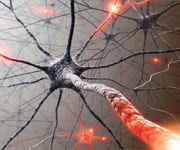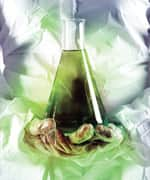Life Extension Magazine®
Researchers long ago verified the important eye benefits of the carotenoid astaxanthin found in algae and other natural sources. Given the direct connection between the eye and the brain, it is not surprising that scientists are discovering that astaxanthin also has important brain health benefits.
Continued exploration into the biological properties of this carotenoid has resulted in the discovery of an array of unexpected brain benefits, including protecting neuronal memory centers against glucose damage.
What separates astaxanthin from most other oxidant scavengers is that it can easily cross the blood-brain barrier. This allows the nutrient greater access to difficult-to-reach parts of the brain.1
A multitude of data shows that astaxanthin can circumvent many diseases through a broad range of functions. In fact, almost every cell of the body, including those in the eyes, heart, and kidney can benefit.2,3
There is now substantial research showing that astaxanthin may provide even greater protection against neurodegeneration.4,5
Protection in the Hippocampus
Glucose-induced cognitive deficits occur in both nondiabetics and diabetics.6,7
The overload of excess glucose passing through the bloodstream causes inflammation and oxidative stress throughout the body. The brain, however, is particularly sensitive to this glut of glucose. Excess glucose damages precious brain cells and leads to neurological diseases such as Alzheimer’s and Parkinson’s.7,8
Scientists have noted that the hippocampus, the part of the brain that stores memory, is highly vulnerable to damage from glucose.7,9
Astaxanthin plays a variety of beneficial roles in the hippocampus. Animal studies show that this unique carotenoid can mitigate diabetes-induced neuronal damage in the hippocampus.9,10
In one study, diabetic mice given astaxanthin had significantly lower amounts of neuronal loss in the hippocampus than mice who didn’t receive astaxanthin. The group that received astaxanthin also recorded inhibition of the master inflammatory molecule NF-kappaB and reduction of pro-inflammatory TNF-alpha.9
Several studies have shown that astaxanthin supplementation decreases oxidative stress and the overexpression of a deadly protein called caspase-3.11-13
The caspase protein is nicknamed the “executioner” protein because of the role it plays in apoptosis (cellular death), necrosis, and inflammation. Caspase-3 has a specific role in executing apoptosis. This protein benefits the body when it is expressed in the correct amount. Overexpression of caspase-3 caused by poor health factors, such as high glucose levels, is harmful because it causes neuronal cell death.14,15
An underappreciated aspect of excess glucose is the acceleration of brain aging it inflicts. Life Extension® has long argued that ideal fasting glucose levels should be below 86 mg/dL. This is a challenging target to achieve as people age and develop metabolic disturbances that cause glucose levels to remain too high. The ability of astaxanthin to protect against glucose-induced neural toxicity is especially important for those unable to achieve optimal glucose control.
Astaxanthin Promotes Cell-Regulating Pathway
 |
The PI3K/AKT pathway is a regulator of various cellular functions throughout the body. The survival of cells is dependent on the expression of this PI3K/AKT pathway.
When the PI3K/AKT pathway becomes dysfunctional, it allows for greater amounts of unwanted cell death. It is now associated with a multitude of human diseases.16-19 Researchers have been aiming their efforts towards finding ways to increase the regulation and expression of the PI3K/AKT pathway to fight many diseases.20
A number of studies have revealed that astaxanthin can promote the PI3K/AKT pathway.10,13 In many of these studies, the researchers proposed that the positive results seen on astaxanthin were largely attributed to its ability to increase the expressions of AKT protein and PI3K.
Human Cognitive Enhancement Studies
Two separate, yet similar, studies on astaxanthin were released in the Journal of Clinical Biochemistry and Nutrition. Researchers demonstrated that supplementation with astaxanthin provided a cognitive boost in the elderly. These human studies further vindicate the role of astaxanthin to increase overall brain health.21,22
The first study was implemented on 10 older males who complained of having age-related forgetfulness. After six weeks of taking oral astaxanthin, there was significant reduction in response time for divided attention tasks (the ability to execute more than one action at a time). After 12 weeks, there was improvement in all cognitive areas with significant improvement in the subjects’ working memory.21
The later study was more comprehensive. The researchers conducted a double-blind placebo-controlled study on 96 subjects, men and women between the ages of 52 and 59. The subjects were tested by card games on a computer.22
They tested the subjects’ working memory by asking whether a card was the same as the previous card. Subjects were also tested on their delayed recall by seeing if they could remember if overturned cards had appeared previously.
After a period of 12 weeks, those who received oral astaxanthin showed significant improvements in both working memory and delayed recall compared to the group that received a placebo.
What You Need to Know
 |
Astaxanthin’s Brain Benefits
- Astaxanthin is a carotenoid that not only provides eye health benefits but also a wide variety of brain benefits, including protecting the brain’s memory centers against glucose damage. Astaxanthin can easily cross the blood-brain barrier, which allows it greater access to difficult-to-reach parts of the brain.
- The hippocampus, the part of the brain that stores memory, is highly vulnerable to glucose damage and astaxanthin plays a variety of beneficial roles in maintaining hippocampus health.
- In one study, subjects who received oral astaxanthin showed significant improvements in both working memory and delayed recall compared to a group that received a placebo.
- Astaxanthin also shows potential to reduce brain damage inflicted by ischemic stroke. In a recent study, astaxanthin reduced brain injury and brain cell death while a control group that did not receive astaxanthin had almost double the mortality rate within 24 hours.
- Researchers note astaxanthin’s direct benefit for epilepsy by protecting the brain by lessening oxidative damage and lipid peroxidation, as well as preventing mitochondrial death. The effects are especially notable when astaxanthin is combined with omega-3.
- Both omega-3 and astaxanthin are found together in crustaceans, algae, and small fish, and it makes sense that the two compounds should be taken together.
Preventing Brain Cell Death in Stroke
Astaxanthin is also exhibiting potential to reduce brain damage inflicted by ischemic stroke.
In a compelling study on astaxanthin, thrombosis (the formation of a blood clot inside a blood vessel) was measured in hypertensive rats. The results showed that astaxanthin was able to inhibit thrombosis from occurring in cerebral vessels.23
The researchers also observed that the usual increase of systolic blood pressure in these stroke-prone rats was suppressed by the astaxanthin treatment. The antihypertensive benefits of astaxanthin were explained by its ability to preserve nitric oxide levels by lowering oxidative stress in the arterial lining.23
In the US, ischemic strokes account for approximately 87% of all strokes.24 When ischemic stroke is left untreated, the patient typically loses 1.9 million neurons per minute. Poor post-stroke functional outcome is attributed to the amount of brain cell death that occurred.25
Striking results on astaxanthin were also observed in another study. Astaxanthin was able to reduce ischemic brain injury in adult rats by preventing neuronal damage and death.26
Intracerebroventricular injection, a direct injection into the brain, of astaxanthin was administered to an experimental group prior to ischemia-induced injury. The rats given astaxanthin exhibited improved post-stroke locomotor activity and reduced cerebral infarctions compared to the placebo. Upon analysis of brain tissue, there was less free radical damage, excitotoxicity, and neuronal brain cell death.26
A subarachnoid hemorrhage is a type of stroke that is usually caused when an aneurysm ruptures in the area between the membranes that cover the brain. An aneurysm is a balloon-like dilation in a weak area of an artery wall that can rupture and cause hemorrhaging. Blood spills out on the circumference of the brain causing massive damage, painful headaches, and cell death (apoptosis) in the brain.
Anti-apoptotic therapies, or treatments to stop cell death in the body, are gaining recognition from researchers as a way to lower the death rate in the event of a subarachnoid hemorrhage.13 Since astaxanthin has been shown to greatly weaken expression of caspase-3 (apoptosis-inducing protein), it would make sense that it would provide such a benefit. In the past few years, studies on astaxanthin have been published showing that it lowered oxidative stress, inflammation, blood brain barrier disruption, brain edema, and neuronal apoptosis from subarachnoid hemorrhage.27-30 These studies pave the way for the therapeutic use of astaxanthin in the treatment of subarachnoid hemorrhage.
The mortality rate six months after a subarachnoid hemorrhage is 50%. A startling 10% to 15% die before ever making it to the hospital.31 In a recent animal study, astaxanthin was shown to reduce brain injury and brain cell death. In addition, the group that did not receive astaxanthin had almost double the mortality rate of 21.1% compared to 11.8% in the group that did receive astaxanthin within 24 hours.13
Astaxanthin’s Eye Health Advantages
 |
Some of the most admired information on astaxanthin has been on its wide variety of benefits to the eyes. Along with the carotenoids zeaxanthin and lutein, astaxanthin has the ability to cross not only the blood-brain barrier but also the blood-eye barrier.32
New research on astaxanthin now provides evidence against cataract formation. An interesting human study was conducted on 35 human patients who had a cataract formation in both eyes. The patients first underwent surgery for one eye without astaxanthin. Later the same surgery was performed on the other eye after the patients supplemented with astaxanthin for two weeks.33
The researchers measured oxidative stress in the aqueous humor, which is the transparent fluid between the lens and cornea. After the initial surgery, patients showed elevated oxidative stress. However, oxidative stress was significantly lower with supplementation of astaxanthin prior to the second surgery.33
In a more recent study, astaxanthin was tested against steroid-induced cataract formation in chick embryos. The researchers tested the opacity (lack of transparency) of the lenses 48 hours after astaxanthin was administered.
Lens opacity was seen in 63% of the group that received no treatment compared to only 26% in the astaxanthin group. Clearly, astaxanthin slashed the chances of eye cloudiness from the steroid.34
Ultraviolet rays, smoking, and a deficiency of vitamins C and E are the greatest risk factors for cataracts.35-37 Since these risk factors can cause an increase in oxidative stress, it is proposed that astaxanthin would be of great value in preserving eye health.34 The results of these studies add greater evidence to support astaxanthin’s role in benefiting those affected by cataracts.33,34
Potential Usage for Epilepsy
Research has shown that oxidative stress contributes to epilepsy and causes severe neuronal damage induced by epilepsy.38,39 There is a wealth of data showing that nutrients such as omega-3s are effective in the prevention and treatment of epilepsy.40-42 However, astaxanthin provides an additional unique benefit to epilepsy patients by crossing the blood-brain barrier to target oxidative stress directly. Astaxanthin’s oxidant-scavenging benefits have intrigued many researchers for its use in the fight against epilepsy.
The amygdala is the part of the brain that controls emotions. Overexcitement, or kindling, of this brain region may directly cause a seizure if there is sufficient neurological damage. Amygdala kindling is the most commonly used form of testing in epilepsy research. It involves the use of a machine that releases an electrical stimulation in the center of the brain.43
In an amygdala-kindling test on rats, astaxanthin was shown to significantly weaken the neuronal damage from the electrical stimulation. The results suggest that astaxanthin was able to guard the brain against this damage by lessening oxidative damage and lipid peroxidation, as well as preventing mitochondrial death.11
It is important to note that this is a recent study and the first to show astaxanthin’s direct benefit for epilepsy. However, there has been significantly more research that shows the ability of omega-3s to prevent epilepsy.40-42 In fact, a recent study involving 70 medically resistant epileptic children demonstrated the benefits of omega-3 on reducing epilepsy. Before the study, all the children averaged four seizures per month. Half of the children received 1,200 mg of fish oil daily and the other half received a placebo. Results showed that 57% of the supplemented group experienced no seizures after three months. Those children receiving a placebo had no appreciable difference in the number of seizures.41
The Synergistic Combination of Astaxanthin and Omega-3s
 |
Lipid peroxidation is the oxidation of fats (lipids), rendering them useless by the body. Omega-3s can be vulnerable to lipid peroxidation unless certain nutrients are taken alongside it.44 Several studies have demonstrated sesame lignans and vitamin E prevent lipid peroxidation, especially for omega-3s.44-46 Astaxanthin is also showing strong evidence in preventing oxidation of omega-3s in this same way. In addition, studies are showing more beneficial effects when these nutrients are taken together.47-49
One of the many markers produced to reduce oxidative stress is glutathione. A study tested the amount of glutathione released in response to supplementation with astaxanthin and omega-3, both separately and in combination. The results of the study showed that the combination of astaxanthin and omega-3 not only worked better to increase the amount of glutathione, but it also increased the ratio of active glutathione to oxidized (inactive) glutathione 6-fold.50
Additional studies show that astaxanthin and omega-3s complement each other and create greater reductions in oxidative stress.48,49 Since these two compounds are found naturally together in crustaceans, algae, and small fish, it would make sense that they should be taken together.51
Summary
Astaxanthin has many lifesaving qualities. One is to protect against cognitive decline. The brain consumes 20% of the body’s oxygen, which makes it more vulnerable to oxidative damage.
Interestingly, astaxanthin can also protect the brain from hypoxia (lack of oxygen). This demonstrates astaxanthin’s ability to help the brain maintain oxygen balance.52
Cognitive decline is experienced by some degree in all aging individuals. Some of the risk factors include oxidative stress,53-55 inflammation,56 decline in hormones,57 endothelial dysfunction,58 insulin resistance,59 and suboptimal nutrition.60 Astaxanthin and omega-3s have been shown to circumvent many of these risk factors.4,9,23,61-63
Supplementing with astaxanthin benefits almost every cell in the body and the research about its value to neurological function is rapidly expanding.3-5
If you have any questions on the scientific content of this article, please call a Life Extension® Health Advisor at 1-866-864-3027.
References
- Liu X, Osawa T. Astaxanthin protects neuronal cells against oxidative damage and is a potent candidate for brain food. Forum Nutr. 2009;61:129-35.
- Higuera-Ciapara I, Felix-Valenzuela L, Goycoolea FM. Astaxanthin: a review of its chemistry and applications. Crit Rev Food Sci Nutr. 2006;46(2):185-96.
- Yuan JP, Peng J, Yin K, et al. Potential health-promoting effects of astaxanthin: a high-value carotenoid mostly from microalgae. Mol Nutr Food Res. 2011;55(1):150-65.
- Wu H, Niu H, Shao A, et al. Astaxanthin as a potential neuroprotective agent for neurological diseases. Mar Drugs. 2015;13(9):5750-66.
- Hussein G, Sankawa U, Goto H, et al. Astaxanthin, a carotenoid with potential in human health and nutrition. J Nat Prod. 2006;69(3):443-9.
- Ravona-Springer R, Moshier E, Schmeidler J, et al. Changes in glycemic control are associated with changes in cognition in non-diabetic elderly. J Alzheimers Dis. 2012;30(2):299-309.
- Wrighten SA, Piroli GG, Grillo CA, et al. A look inside the diabetic brain: Contributors to diabetes-induced brain aging. Biochimica et biophysica acta. 2009;1792(5):444-53.
- Zhang P, Tian B. Metabolic syndrome: an important risk factor for Parkinson’s disease. Oxid Med Cell Longev. 2014;2014:729194.
- Zhou X, Zhang F, Hu X, et al. Inhibition of inflammation by astaxanthin alleviates cognition deficits in diabetic mice. Physiol Behav. 2015;151:412-20.
- Xu L, Zhu J, Yin W, et al. Astaxanthin improves cognitive deficits from oxidative stress, nitric oxide synthase and inflammation through upregulation of PI3K/Akt in diabetes rat. Int J Clin Exp Pathol. 2015;8(6):6083-94.
- Lu Y, Xie T, He XX, et al. Astaxanthin rescues neuron loss and attenuates oxidative stress induced by amygdala kindling in adult rat hippocampus. Neurosci Lett. 2015;597:49-53.
- Wen X, Huang A, Hu J, et al. Neuroprotective effect of astaxanthin against glutamate-induced cytotoxicity in HT22 cells: Involvement of the Akt/GSK-3beta pathway. Neuroscience. 2015;303:558-68.
- Zhang XS, Zhang X, Wu Q, et al. Astaxanthin alleviates early brain injury following subarachnoid hemorrhage in rats: possible involvement of Akt/bad signaling. Mar Drugs. 2014;12(8):4291-310.
- Li P, He QP, Ouyang YB, et al. Early release of cytochrome C and activation of caspase-3 in hyperglycemic rats subjected to transient forebrain ischemia. Brain Res. 2001;896(1-2):69-76.
- Sharifi AM, Eslami H, Larijani B, et al. Involvement of caspase-8, -9, and -3 in high glucose-induced apoptosis in PC12 cells. Neurosci Lett. 2009;459(2):47-51.
- Costa C, Pereira S, Lima L, et al. Abnormal protein glycosylation and activated PI3K/Akt/mTOR pathway: role in bladder cancer prognosis and targeted therapeutics. PLoS One. 2015;10(11):e0141253.
- Hauge M, Bruserud O, Hatfield KJ. Targeting of cell metabolism in human acute myeloid leukemia - more than targeting of IDH mutations and PI3K-AKT-mTOR signaling? Eur J Haematol. 2015.
- Petrulea MS, Plantinga TS, Smit JW, et al. PI3K/Akt/mTOR: A promising therapeutic target for non-medullary thyroid carcinoma. Cancer Treat Rev. 2015;41(8):707-13.
- Su H, Gu Y, Li F, et al. The PI3K/AKT/mTOR signaling pathway is overactivated in primary aldosteronism. PLoS One. 2013;8(4):e62399.
- Available at: http://www.cellsignal.com/common/content/content.jsp?id=pathways-akt-signaling. Accessed January 6, 2016.
- Satoh A, Tsuji S, Okada Y, et al. Preliminary clinical evaluation of toxicity and efficacy of a new astaxanthin-rich Haematococcus pluvialis extract. J Clin Biochem Nutr. 2009;44(3):280-4.
- Katagiri M, Satoh A, Tsuji S, et al. Effects of astaxanthin-rich Haematococcus pluvialis extract on cognitive function: a randomised, double-blind, placebo-controlled study. J Clin Biochem Nutr. 2012;51(2):102-7.
- Sasaki Y, Kobara N, Higashino S, et al. Astaxanthin inhibits thrombosis in cerebral vessels of stroke-prone spontaneously hypertensive rats. Nutr Res. 2011;31(10):784-9.
- Mozaffarian D, Benjamin EJ, Go AS, et al. Heart disease and stroke statistics--2015 update: a report from the American Heart Association. Circulation. 2015;131(4):e29-322.
- Saver JL. Time is brain-quantified. Stroke. 2006;37(1):263-6.
- Shen H, Kuo CC, Chou J, et al. Astaxanthin reduces ischemic brain injury in adult rats. Faseb j. 2009;23(6):1958-68.
- Wu Q, Zhang XS, Wang HD, et al. Astaxanthin activates nuclear factor erythroid-related factor 2 and the antioxidant responsive element (Nrf2-ARE) pathway in the brain after subarachnoid hemorrhage in rats and attenuates early brain injury. Mar Drugs. 2014;12(12):6125-41.
- Zhang XS, Zhang X, Wu Q, et al. Astaxanthin offers neuroprotection and reduces neuroinflammation in experimental subarachnoid hemorrhage. J Surg Res. 2014;192(1):206-13.
- Zhang XS, Zhang X, Zhang QR, et al. Astaxanthin reduces matrix metalloproteinase-9 expression and activity in the brain after experimental subarachnoid hemorrhage in rats. Brain Res. 2015;1624:113-24.
- Zhang XS, Zhang X, Zhou ML, et al. Amelioration of oxidative stress and protection against early brain injury by astaxanthin after experimental subarachnoid hemorrhage. J Neurosurg. 2014;121(1):42-54.
- Available at: http://emedicine.medscape.com/article/794076-overview. Accessed January 8, 2016.
- Available at: www.google.com/patents/us5527533. Accessed January 8, 2016.
- Hashimoto H, Arai K, Hayashi S, et al. Effects of astaxanthin on antioxidation in human aqueous humor. J Clin Biochem Nutr. 2013;53(1):1-7.
- Ishikawa S, Hashizume K, Nishigori H, et al. Effect of astaxanthin on cataract formation induced by glucocorticoids in the chick embryo. Curr Eye Res. 2015;40(5):535-40.
- Hiller R, Sperduto RD, Podgor MJ, et al. Cigarette smoking and the risk of development of lens opacities. The Framingham studies. Arch Ophthalmol. 1997;115(9):1113-8.
- Jacques PF, Chylack LT, Jr. Epidemiologic evidence of a role for the antioxidant vitamins and carotenoids in cataract prevention. Am J Clin Nutr. 1991;53(1 Suppl):352s-5s.
- Taylor HR, West SK, Rosenthal FS, et al. Effect of ultraviolet radiation on cataract formation. N Engl J Med. 1988;319(22):1429-33.
- Sashindranath M, McLean KJ, Trounce IA, et al. Early hippocampal oxidative stress is a direct consequence of seizures in the rapid electrical amygdala kindling model. Epilepsy Res. 2010;90(3):285-94.
- Waldbaum S, Patel M. Mitochondria, oxidative stress, and temporal lobe epilepsy. Epilepsy Res. 2010;88(1):23-45.
- DeGiorgio CM, Miller PR, Harper R, et al. Fish oil (n-3 fatty acids) in drug resistant epilepsy: a randomised placebo-controlled crossover study. J Neurol Neurosurg Psychiatry. 2015;86(1):65-70.
- Reda DM, Abd-El-Fatah NK, Omar Tel S, et al. Fisho intake and seizure control in children with medically resistant epilepsy. N Am J Med Sci. 2015;7(7):317-21.
- Yuen AW, Flugel D, Poepel A, et al. Non-randomized open trial of eicosapentaenoic acid (EPA), an omega-3 fatty acid, in ten people with chronic epilepsy. Epilepsy Behav. 2012;23(3):370-2.
- Bertram E. The relevance of kindling for human epilepsy. Epilepsia. 2007;48 Suppl 2:65-74.
- Yamashita K, Kagaya M, Higuti N, et al. Sesamin and alpha-tocopherol synergistically suppress lipid-peroxide in rats fed a high docosahexaenoic acid diet. Biofactors. 2000;11(1-2):11-3.
- Ide T, Hong DD, Ranasinghe P, et al. Interaction of dietary fat types and sesamin on hepatic fatty acid oxidation in rats. Biochim Biophys Acta. 2004;1682(1-3):80-91.
- Ikeda S, Kagaya M, Kobayashi K, et al. Dietary sesame lignans decrease lipid peroxidation in rats fed docosahexaenoic acid. J Nutr Sci Vitaminol (Tokyo). 2003;49(4):270-6.
- Barros MP, Poppe SC, Bondan EF. Neuroprotective properties of the marine carotenoid astaxanthin and omega-3 fatty acids, and perspectives for the natural combination of both in krill oil. Nutrients. 2014;6(3):1293-317.
- Saw CL, Yang AY, Guo Y, et al. Astaxanthin and omega-3 fatty acids individually and in combination protect against oxidative stress via the Nrf2-ARE pathway. Food Chem Toxicol. 2013;62:869-75.
- Otton R, Marin DP, Bolin AP, et al. Combined fish oil and astaxanthin supplementation modulates rat lymphocyte function. Eur J Nutr. 2012;51(6):707-18.
- Mattei R, Polotow TG, Vardaris CV, et al. Astaxanthin limits fish oil-related oxidative insult in the anterior forebrain of Wistar rats: putative anxiolytic effects? Pharmacol Biochem Behav. 2011;99(3):349-55.
- Ambati RR, Phang SM, Ravi S, et al. Astaxanthin: sources, extraction, stability, biological activities and its commercial applications--a review. Mar Drugs. 2014;12(1):128-52.
- Yamagishi R, Aihara M. Neuroprotective effect of astaxanthin against rat retinal ganglion cell death under various stresses that induce apoptosis and necrosis. Mol Vis. 2014;20:1796-805.
- Butterfield DA, Sultana R. Redox proteomics identification of oxidatively modified brain proteins in Alzheimer’s disease and mild cognitive impairment: insights into the progression of this dementing disorder. J Alzheimers Dis. 2007;12(1):61-72.
- Lovell MA, Markesbery WR. Oxidative DNA damage in mild cognitive impairment and late-stage Alzheimer’s disease. Nucleic Acids Res. 2007;35(22):7497-504.
- Mecocci P, MacGarvey U, Beal MF. Oxidative damage to mitochondrial DNA is increased in Alzheimer’s disease. Ann Neurol. 1994;36(5):747-51.
- Schram MT, Euser SM, de Craen AJ, et al. Systemic markers of inflammation and cognitive decline in old age. J Am Geriatr Soc. 2007;55(5):708-16.
- Yaffe K, Barnes D, Lindquist K, et al. Endogenous sex hormone levels and risk of cognitive decline in an older biracial cohort. Neurobiol Aging. 2007;28(2):171-8.
- Rizzo MT, Leaver HA. Brain endothelial cell death: modes, signaling pathways, and relevance to neural development, homeostasis, and disease. Mol Neurobiol. 2010;42(1):52-63.
- Okereke OI, Kurth T, Pollak MN, et al. Fasting plasma insulin, C-peptide and cognitive change in older men without diabetes: results from the Physicians’ Health Study II. Neuroepidemiology. 2010;34(4):200-7.
- Scarmeas N, Stern Y, Mayeux R, et al. Mediterranean diet and mild cognitive impairment. Arch Neurol. 2009;66(2):216-25.
- Gammone MA, Riccioni G, D’Orazio N. Marine Carotenoids against oxidative stress: effects on human health. Mar Drugs. 2015;13(10):6226-46.
- Gammone MA, Riccioni G, D’Orazio N. Carotenoids: potential allies of cardiovascular health? Food Nutr Res. 2015;59:26762.
- Ni Y, Nagashimada M, Zhuge F, et al. Astaxanthin prevents and reverses diet-induced insulin resistance and steatohepatitis in mice: A comparison with vitamin E. Sci Rep. 2015;5:17192.

